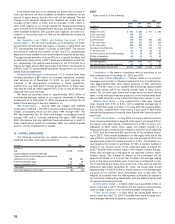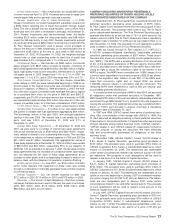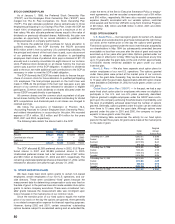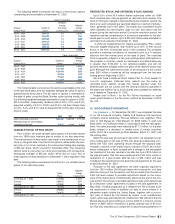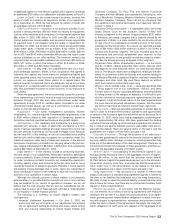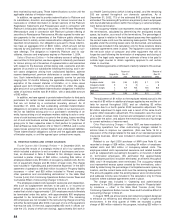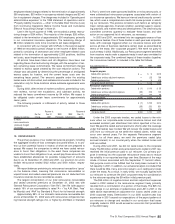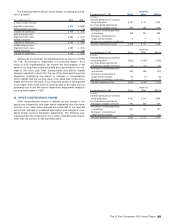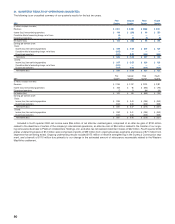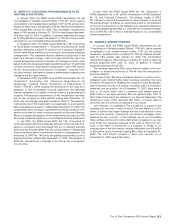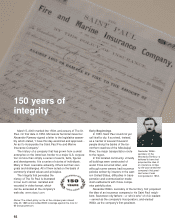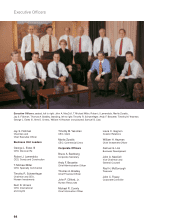Travelers 2002 Annual Report Download - page 87
Download and view the complete annual report
Please find page 87 of the 2002 Travelers annual report below. You can navigate through the pages in the report by either clicking on the pages listed below, or by using the keyword search tool below to find specific information within the annual report.
employee-related charges related to the termination of approximately
590 employees, $33 million in occupancy-related charges and $2 mil-
lion in equipment charges.The charge was included in “Operating and
administrative expenses” in the 1999 statement of operations and in
“Property-liability insurance — other” in the table titled “Income (Loss)
from Continuing Operations Before Income Taxes and Cumulative
Effect of Accounting Change” in Note 21.
Late in the fourth quarter of 1998, we recorded a pretax restruc-
turing charge of $34 million. The majority of the charge, $26 million,
related to the termination of approximately 500 employees, primarily
in our commercial insurance operations. The remaining charge of
$8 million related to costs to be incurred to exit lease obligations.
In connection with our merger with USF&G, in the second quarter
of 1998 we recorded a pretax charge to net income of $292 million,
primarily consisting of severance and other employee-related costs
related to the termination of approximately 2,200 positions, facilities
exit costs, asset impairments and transaction costs.
All actions have been taken and all obligations have been met
regarding these other restructuring charges, with the exception of cer-
tain remaining lease commitments. The lease commitment charges
related to excess space created by the cost reduction actions. The
charge was calculated by determining the percentage of anticipated
excess space, by location, and the current lease costs over the
remaining lease period. The amounts payable under the existing
leases were not discounted, and sublease income was included in the
calculation only for those locations where sublease agreements were
in place.
During 2002, after review of market conditions, potential buy-outs,
rent reviews, normal rent escalations, and sublease activity; we
reduced the lease commitment reserve by $4 million. We expect to
be obligated under certain lease commitments for approximately
seven years.
The following presents a rollforward of activity related to these
commitments.
Reserve at Reserve at
Pre-Tax Dec. 31, 2002 2002 Dec. 31,
Charges to earnings: Charge 2001 Payments Adjustments 2002
(In millions)
Lease commitments
previously charged
to earnings $ 91 $ 39 $(11) $ (4) $ 24
19. REINSURANCE
The primary purpose of our ceded reinsurance program, including
the aggregate excess-of-loss coverages discussed below, is to pro-
tect us from potential losses in excess of what we are prepared to
accept. We expect the companies to which we have ceded reinsur-
ance to honor their obligations. In the event these companies are
unable to honor their obligations to us, we will pay these amounts.We
have established allowances for possible nonpayment of amounts
due to us. At December 31, 2002 and 2001, our provision for uncol-
lectible reinsurance totaled $122 million and $100 million, respec-
tively.
We report balances pertaining to reinsurance transactions “gross”
on the balance sheet, meaning that reinsurance recoverables on
unpaid losses and ceded unearned premiums are not deducted from
insurance reserves but are recorded as assets.
The largest concentration of our total reinsurance recoverables
and ceded unearned premiums at December 31, 2002 was with
General Reinsurance Corporation (“Gen Re”). Gen Re (with approxi-
mately 19% of our recoverables) is rated “A+ +” by A.M. Best, “Aaa”
by Moody’s and “AAA” by Standard & Poor’s for its financial strength.
Approximately 98% of our domestic reinsurance recoverable bal-
ances at December 31, 2002 were with reinsurance companies hav-
ing financial strength ratings of A- or higher by A.M Best or Standard
& Poor’s, were from state sponsored facilities or reinsurance pools, or
were collateralized reinsurance programs associated with certain of
our insurance operations. We have an internal credit security commit-
tee, which uses a comprehensive credit risk review process in select-
ing our reinsurers. This process considers such factors as ratings by
major ratings agencies, financial condition, parental support, operat-
ing practices, and market news and developments.The credit security
committee convenes quarterly to evaluate these factors and take
action on our approved list of reinsurers, as necessary.
In 2000 and 2001, we entered into two aggregate excess-of-loss
reinsurance treaties.One of these treaties in each year was corporate-
wide, with coverage triggered when our insurance losses and LAE
across all lines of business reached a certain level, as prescribed by
terms of the treaty (the “corporate program”). We were not party to
such a treaty in 2002. Additionally, our Reinsurance segment benefited
from cessions made under a separate treaty in each year unrelated to
the corporate treaty. The combined impact of these treaties (together,
the “reinsurance treaties”) is included in the table that follows.
Years ended December 31 2002 2001 2000
(In millions)
Corporate program:
Ceded written premiums $— $9 $419
Ceded losses and loss adjustment expenses —(25) 709
Ceded earned premiums —9419
Net pretax benefit (detriment) $— $(34) $ 290
Reinsurance segment treaty:
Ceded written premiums $(1) $119 $ 55
Ceded losses and loss adjustment expenses (35) 278 122
Ceded earned premiums (1) 119 55
Net pretax benefit $(34) $159 $ 67
Combined total:
Ceded written premiums $(1) $128 $ 474
Ceded losses and loss adjustment expenses (35) 253 831
Ceded earned premiums (1) 128 474
Net pretax benefit $(34) $125 $ 357
Under the 2000 corporate treaties, we ceded losses to the rein-
surer when our corporate-wide incurred insurance losses and LAE
exceeded accident year attachment loss ratios specified in the con-
tract. We paid the ceded earned premiums shortly after the coverage
under the treaties was invoked. We will recover the ceded losses and
LAE from our reinsurer as we settle the related claims, which may
occur over several years. For the separate Reinsurance segment
treaties, for all three years, we remit the premiums ceded (plus
accrued interest) to our counter-party when the related losses and
LAE are settled.
During 2002 and 2001, we did not cede losses to the corporate
treaty.The $9 million written and earned premiums ceded in 2001 rep-
resented the initial premium paid to our reinsurer. Our primary pur-
pose in entering into the corporate reinsurance treaty was to reduce
the volatility in our reported earnings over time. Because of the mag-
nitude of losses associated with the September 11 terrorist attack,
that purpose could not be fulfilled had the treaty been invoked to its
full capacity in 2001. In addition, our actuarial analysis concluded that
there would be little, if any, economic value to us in ceding any losses
under the treaty. As a result, in early 2002, we mutually agreed with
our reinsurer to commute the 2001 corporate treaty for consideration
to the reinsurer equaling the $9 million initial premium paid.
The $35 million of negative losses and loss adjustment expenses
ceded in 2002 related to the reinsurance segment treaty primarily
resulted from a commutation of a portion of that treaty. The $25 mil-
lion change in our estimate of ceded losses and LAE in 2001 in the
table above represented an adjustment for losses ceded under our
2000 corporate treaty. Deterioration in our 2000 accident year loss
experience in 2001 caused our expectations of the payout patterns of
our reinsurer to change and resulted in our conclusion that losses
originally ceded in 2000 would exceed an economic limit prescribed
in the 2000 treaty.
The St. Paul Companies 2002 Annual Report 85



